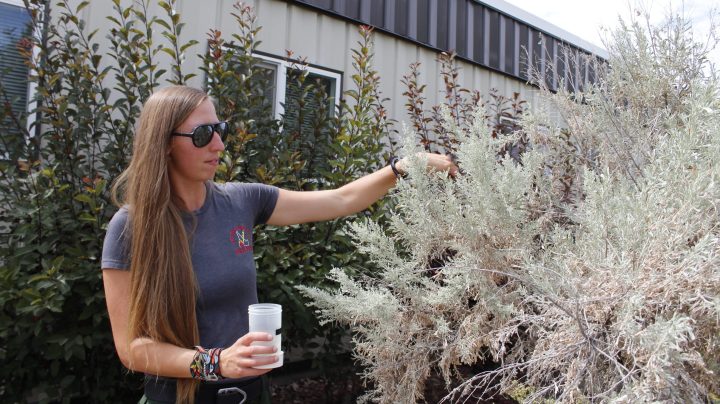
How much water is in plants? The answer can be critical to forecasting wildfires.
How much water is in plants? The answer can be critical to forecasting wildfires.

On a recent 99-degree afternoon, Taylor Zarifis was plucking leaves off a tall sagebrush in front of a federal Bureau of Land Management building in Boise, Idaho.
“We’re only collecting the live leaves,” she explained.
Zarifis is a fuels technician, and she was collecting the brush to demonstrate how to calculate “fuel moisture,” which refers to how much water is in live plants.
“So any of this dead stuff, we’ll avoid. And then also, if you have bugs or any fungus or anything on the leaves, we’ll avoid picking off of those too.”
Temperatures in many parts of the country have been at record levels this summer. And as we all know, when it gets hot, plants dry out — and dry plants fuel wildfires.
Zarifis and others at the Boise office visit sites around southern Idaho every few weeks to collect parts of plants like sagebrush and juniper. Many other BLM offices collect this kind of data too, sampling different shrubs or trees in their own area. But that’s only the first phase of getting a fuel moisture reading.
From there, they bring those plant samples to an office that’s about the size of a large closet. To measure how much moisture is in these plants, machines weigh them, then bake out the moisture and calculate how much evaporated.
The moisture level is critical.
Nolin Page, another fuels technician in Boise, used to work as a firefighter. He said those numbers tell wildfire personnel how easily a fire might start, or how quickly it could spread.
“For just a basic firefighter, it’s not so much of something I can change, but I can anticipate it. But for management, [that] is where the real change is because they will address their funding needs, resource needs, allocate people where they need,” he said.
Federal resources have increased for wildland firefighting efforts by 60% over the last four years, to $1.5 billion.
However, last year, the U.S. maintained the highest wildfire preparedness levels, 4 and 5, for a record amount of time: 99 days. That meant officials had to be careful about how they allocated firefighting resources because blazes require thousands of people.
So fuel moisture data has become critical for forecasting where firefighters and equipment need to go. And decades of data are available now, largely thanks to a project started in Nevada 40 years ago called the Great Basin Live Fuel Moisture Project.
“We’re going back to 1980, ‘82-ish, right around there,” said Sandy Gregory, who worked on the project from the beginning with its founders, Greg Zschaechner and Marcus Schmidt. “We developed, or they developed, an applied science project based off of plant biology,” she said.
She said they started just trying to figure out the best way to get accurate moisture levels from live plants.
Then people started to realize how important it could be to aggregate that data. Offices in other states even sent brush to Nevada to get moisture levels.
Meanwhile, the program grew. Gregory said it went from a shed in Carson City to a shed in Reno to a real lab, where it was easier to work through hundreds of plant samples. She led the program from 1993 to 2015.
“Gosh, at one point in time, you know, we had somewhere around 100 canisters, and some of them would have nine different samples in them,” Gregory said.
Now, many Bureau of Land Management field offices have their own ovens to check the fuel moisture levels, and the agency shares them online. With climate change and drought altering the Western landscape, that data is a more critical firefighting tool than ever.
There’s a lot happening in the world. Through it all, Marketplace is here for you.
You rely on Marketplace to break down the world’s events and tell you how it affects you in a fact-based, approachable way. We rely on your financial support to keep making that possible.
Your donation today powers the independent journalism that you rely on. For just $5/month, you can help sustain Marketplace so we can keep reporting on the things that matter to you.











